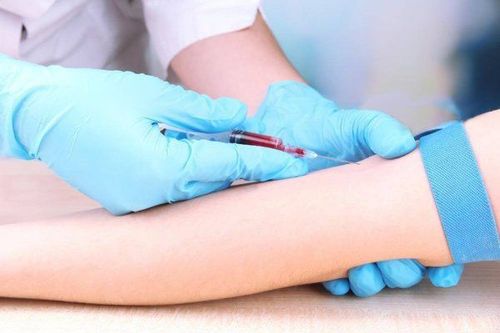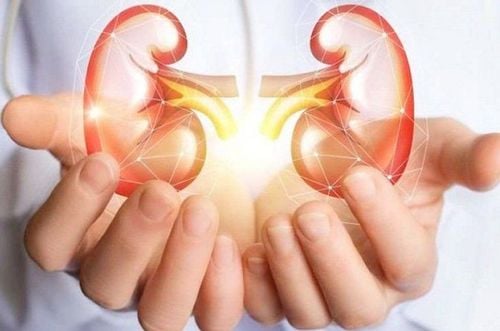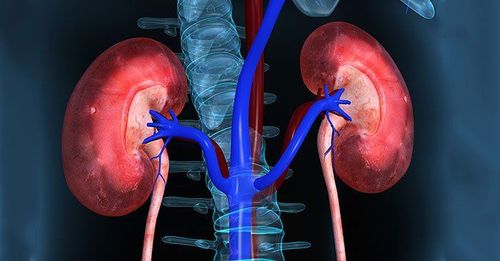This is an automatically translated article.
The article was professionally consulted with Doctor Vo Ha Bang Suong - General Internal Medicine - Department of Examination & Internal Medicine - Vinmec Phu Quoc International General Hospital.Potassium disorder is one of the common electrolyte disorders in clinical practice. Potassium affects nerve cells; When potassium levels are low, cells cannot polarize and release energy continuously, making muscles and nerves unable to function properly.
1. Causes of hypokalemia
Hypokalemia can be caused by decreased potassium intake, but is usually due to excessive loss of potassium in the urine or from the gastrointestinal tract.1.1 Loss of potassium through the kidneys

Hạ kali có thể dẫn đến hạ magie, hạ clo trong máu
Some of the following may occur:
Primary adrenal gland disease (congenital adrenal hyperplasia, adrenal tumor or secondary (Cushing's syndrome) causes steroid excess, leading to secondary hyperaldosteronism. primary aldosterol-secreting tumors Ingesting substances such as glycyrrhizin (found naturally in licorice and used in the manufacture of chewing tobacco), inhibits the enzyme 11 beta-hydroxysteroid dehydrogenase (11β-HSDH), prevents the conversion of cortisol , which has salt water activity, to cortisone, which does not lead to high cortisol levels and renal potassium excretion Some rare genetic conditions: + Bartter syndrome, an underlying disorder known as the condition Excessive renin and aldosterone production, increased renal excretion of potassium and sodium, a consequence of mutations in the sensitive ion transport mechanism of loop diuretics in the loop of Henle
+ Gitelman's syndrome: Similar to Bartter's syndrome, Gitelman's syndrome There is also an overproduction of renin and aldosterone, renal excretion of potassium and sodium, mutations in t in the transport of thiazide-sensitive ions in the distal tubule.
+ Liddle syndrome is a rare autosomal recessive disorder characterized by high blood pressure and severe hypokalemia. Liddle syndrome is caused by uncontrolled sodium absorption in the distal tubule. Improper absorption of high concentrations of sodium increases blood pressure and the kidneys excrete potassium.
Kidney rejection of potassium can also be caused by many congenital and acquired kidney diseases, such as renal tubular acidosis and Fanconi's Syndrome, an abnormal syndrome that causes the excretion of potassium, glucose, phosphate, uric acid, and acid. amine. Hypomagnesemia is a commonly associated condition of hypokalemia. Much of this correlation is due to common causes (eg, diuretics, diarrhea), but hypomagnesemia may itself increase renal potassium loss.
1.2 Loss of potassium through the gastrointestinal tract
Vomiting or loss due to gastric tube drainage causes loss of renal potassium by metabolic alkalosis and stimulation of aldosterone secretion by volume depletion; Aldosterone and metabolic alkalosis both cause the kidneys to excrete potassium. Bile drainage, ileostomy, after small bowel surgery. Acute and chronic diarrhea. Enemas or laxatives.1.3. Movement in cells
The situation of potassium shifting from the extracellular to the cell causing hypokalemia can be encountered in the following cases:Using insulin intravenously in the treatment of diabetes, glucose infusion, using sodium bicarbonate. Stimulation of the sympathetic nervous system, particularly with beta2 agonists (eg, Theophylline, albuterol, terbutaline), may increase cellular potassium absorption. Hypokalemia caused by thyrotoxicosis is an indirect consequence of this mechanism, Familial Periodic Paralysis: a rare autosomal dominant disorder characterized by transient episodes of severe hypokalemia due to thyrotoxicosis. is the sudden abnormal movement of potassium into the cell.
1.4 Due to drugs
Diuretics are the drugs most commonly used to cause hypokalemia: Thiazides. Loop diuretic. Osmotic diuretics Laxatives, which cause diarrhea are also common causes of hypokalaemia. Particular attention should be paid to subjects with paralysis who have to lie down for a long time, use laxatives to support, or subjects to lose weight using drugs of the long-term fat absorption reduction group. Some other drugs cause hypokalemia: + Corticosteroids.+ Some antibiotics: Penicillin resistant to blue pus bacilli (eg carbenicillin), high dose Penicillin
+ Treatment of vitamin B12 and folic acid deficiency.
2. Common clinical symptoms
Signs of neuromuscular disorders: Paresthesias, weakness-myasthenia, decreased reflexes of tendons and bones, intestinal paralysis, constipation, sometimes diarrhea, or vomiting a lot, vomiting is difficult to control. Cardiac and hemodynamic disturbances. Postural hypotension, fainting, severe sometimes coma. More sensitive to digitalis drugs. Electrocardiographic changes: Low-flat T wave, appearance of U wave, negative T wave, reversal, high sharp U wave, long PR interval, low ST segment, grade atrioventricular block (Grade I, II) , III) Reduced glucose tolerance. Alkalosis makes it easier for cirrhotic patients to enter a hepatic coma.
Rối loạn nhịp tim có thể là một trong những triệu chứng của bệnh hạ kali
3. Diagnosis of Hypokalemia
Diagnose hypokalemia when clinical symptoms are suggestive, taking a careful family history. Definitive diagnosis is based on serum potassium test.Diagnosis of hypokalemia when serum potassium concentration is < 3.5 mmol/L
4. Treatment of hypokalemia
Mild hypokalemia (potassium 3.0 – 3.4 mmol/L). Oral potassium chloride should be used. Test potassium levels every day to adjust. Find and treat the cause.Moderate hypokalemia (potassium 2.5 – 2.9 mmol/L and no symptoms). Use oral potassium chloride. Alternatively, intravenous infusion can be used if the oral route is difficult to tolerate (due to excessive vomiting or the patient's poor appetite). Monitor electrocardiogram and test blood potassium levels to adjust. Find and treat the cause.
Severe hypokalemia (potassium < 2.5 mmol/L), or symptomatic hypokalemia, or hypokalemia 2.5 - 2.9 mmol/L in patients taking digitalis drugs (digoxin). In this case, intravenous potassium chloride is preferred (slow intravenous isotonic phase). Monitor electrocardiogram and clinical symptoms (if any). Repeat blood potassium testing every time 40 mmol K+ is transfused to adjust serum potassium levels in accordance with symptoms. In particular, high concentrations of potassium chloride (>40 mmol/L) given intravenously can cause aseptic inflammation of the veins, so it is recommended that the infusion be administered by a central venous line, or by the use of an electric syringe pump for careful dose control.
* Note that severe hypokalemia can cause very severe arrhythmias, especially in cardiac patients. Treatment of hypokalemia must be based on blood potassium testing and close ECG monitoring to adjust the dose of potassium intake, avoiding the risk of causing hyperkalemia, or conversely, ineffective compensation due to insufficient. Attention should be paid to prophylactic treatment in patients at risk of hypokalemia.
Vinmec International General Hospital is one of the hospitals that not only ensures professional quality with a team of leading medical doctors, modern equipment and technology, but also stands out for its examination and consultation services. comprehensive and professional medical consultation and treatment; civilized, polite, safe and sterile medical examination and treatment space. Customers when choosing to perform tests here can be completely assured of the accuracy of test results.
Please dial HOTLINE for more information or register for an appointment HERE. Download MyVinmec app to make appointments faster and to manage your bookings easily.













